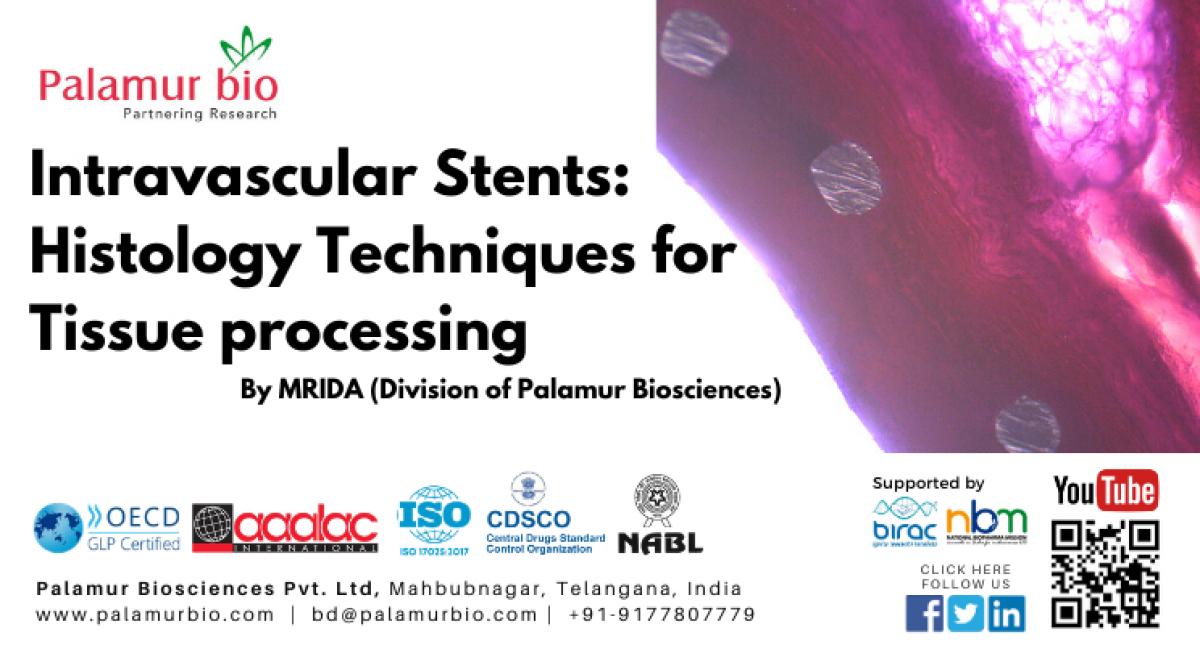Published on September 17, 2020
By Dr. D.C. Sharma, Dr. V. Sthevaan, Dr. S. Anoop, SK. Jahangeer, G. Hanumanth and M. Vasanthan
Histology evaluation of the vascular response to stent implantation in a pre-clinical set up (porcine model) is altogether a different process due to difficulties in sectioning metal and tissue without disturbing the interface of tissue and stent. Care has to be taken to keep the stent integrated with the arterial endothelial lining while processing it. The histo-processing of the arterial tissue with stent needs to lead to a thin section with an intact tissue stent interface for microscopy analysis. We at Palamur Biosciences are happy to share information on the most suitable cutting and grinding equipment, method for resin embedding, and stained sections of stented arteries in situ for histological analysis
The safety and performance evaluation of the coronary stent was done in the porcine model (the most suitable model to test cardiovascular devices). A balloon dilatation cobalt chromium stent was implanted in the right coronary artery of pig. We used standard Percutaneous Transluminal Coronary Angioplasty (PTCA) method to implant coronary stent in right coronary artery, followed by Thrombolysis In Myocardial Infarction (TIMI) risk scoring and quantitative coronary analysis (QCA) for stent induced stenosis (Early Lumen Loss).
Cobalt Chromium Stent implantation at Nominal Balloon Pressure
Quantitative Coronary Analysis (QCA) of the Right Coronary Artery (RCA) with Stent
The follow up angiography and QCA was done after 28 days for Thrombolysis In Myocardial Infarction (TIMI) risk scoring and stent induced stenosis (Late Lumen Loss). Heart was collected to excise the right coronary artery with target stent area.
Radiography Image of Heart with Stent in Right Coronary Artery
The excised stented arterial segment was formalin fixed, embedded in resin (T9100, Technovit Kit), and sectioned at two different speeds using Struer’s Secotome 60; a high speed precision cutting machine.
Resin (T9100) Embedded Stented Arterial Tissue Block
Struer's Secotome 60: Precision Cutting Machine Cutting Resin Embedded Tissue Blocks
This section is mounted with glue on the slide and polished using Metco Bainpol Grinding Polishing machine to 5 µm thickness.
Metco Bainpol Grinding Polishing Machine
The 5 µm section is then stained with Hematoxylin & Eosin staining to assess extent of luminal stenosis, inflammation, vascular injury, endothelialization and presence or absence of peri-strut fibrin deposits upon stent deployment.
The stained tissue section is evaluated for microscopy analysis using Leica LAS V4.12 Digital Image Analysis Software. The Percentage luminal stenosis was calculated by the formula: [1 - (lumen area / internal elastic lamina area)] x 100, as described by Schwartz et al JACC 1992;19:267-74.
Hematoxylin and Eosin Stained Right Coronary Artery with Stent Strut (Leica LAS V4.12 Digital Image Analysis Software)
A semi-quantitative score was graded via the extent of inflammation as described by Kornowski et al JACC 1998;31:224-30, where 0 (no inflammatory cell near strut); 1 (light, non-circumferential inflammatory infiltrate near strut); 2 (localized, moderate to dense inflammatory aggregate near strut); 3 (circumferential dense inflammatory infiltrate of the strut).
Vascular injury was graded according to Schwartz et al JACC 1992;19:267-74, where 0 (intact internal elastic lamina); 1 (laceration of internal elastic lamina); 2 (laceration until media layer); 3 (laceration until external elastic lamina / adventitial layer).
Percentage endothelialization of the stent strut was estimated by using formula: [1 - [nonendothelialized circumference of stented lumen / total luminal circumference)] x 100, where endothelialization is defined as cellular coverage of stent struts or luminal space by all peri-vascular cell types.
CONCLUSION:
Resin embedding with Technovit kit T9100 (Glycol Methacrylate) enabled creating sufficiently hard resin embedded blocks, the Struer’s Secotome 60 produced minimum 400 µm thick sections and Metco Bainpol grinder/polisher unit reliably reduced this thickness to 5 µm. Stented porcine arterial sections showed preserved arterial architecture with the struts in situ with no restenosis or stent induced inflammation. This study identified the optimal method for embedding, sectioning, grinding, and slide mounting of stented artery to achieve 5 µm sections with an intact tissue metal interface, excellent surface qualities, histological staining properties for arterial lumen and endothelialization examination.
REFERENCES:
Ran Kornowski, Mun K Hong, Fermin O Tio, Orville Bramwell, Hongsheng Wu and Martin B Leon (1998) In-Stent Restenosis: Contributions of Inflammatory Responses and Arterial Injury to Neointimal Hyperplasia. J Am Coll Cardiol. 1: 224-230.
Robert S. Schwartz, Kenneth C. Huber, Joseph G. Murphy, William D. Edwards, Allan R. Camrud, Ronald E. Vlietstra, David R. Holmes (1992) Restenosis and the Proportional Neointimal Response to Coronary Artery Injury: Results in a Porcine Model JACC 19-2: 267-74.



